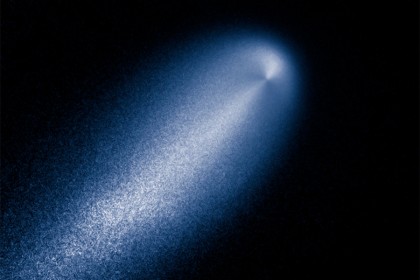Astronomers have observed what most likely are strong carbon dioxide emissions from Comet ISON, emissions that are slowly fizzing away from the so-called soda-pop comet along with dust in a tail about 186,400 miles long.

Image caption: An image of Comet ISON take by NASA's Hubble Space Telescope.
Image credit: NASA/JPL-Caltech
Images of ISON were captured last month with NASA's Spitzer Space Telescope ahead of the comet's anticipated pass through the inner solar system later this year.
"We estimate ISON is emitting about 2.2 million pounds of what is most likely carbon dioxide gas and about 120 million pounds of dust every day," said Carey Lisse, leader of NASA's Comet ISON Observation Campaign and a senior research scientist at the Johns Hopkins University Applied Physics Laboratory. "Previous observations ... gave us only upper limits for any gas emission from ISON. Thanks to Spitzer, we now know for sure the comet's distant activity has been powered by gas."
Comet ISON—officially known as C/2012 S1—is less than three miles in diameter, about the size of a small mountain, and weighs between 7 billion and 7 trillion pounds. Because the comet is still very far away, its true size and density have not been determined accurately. Like all comets, ISON is a dirty snowball made up of dust and frozen gases such as water, ammonia, methane, and carbon dioxide.
The comet is warming up gradually as it gets closer to the sun, and in the process, different gases are heating up to the point of evaporation. Carbon dioxide is thought to be the gas that powers emission for most comets between the orbits of Saturn and the asteroids. ISON will pass within 724,000 miles of the sun on Nov. 28. If it survives the sun's heat, experts say it might glow as brightly as the moon and be briefly visible in daylight, CNN reported recently.
"These fabulous observations of ISON are unique and set the stage for more observations and discoveries to follow as part of a comprehensive NASA campaign to observe the comet," said James L. Green, NASA's director of planetary science in Washington. "ISON is very exciting. We believe that data collected from this comet can help explain how and when the solar system first formed."
Read more from Applied Physics LaboratoryPosted in Science+Technology
Tagged applied physics laboratory, space








